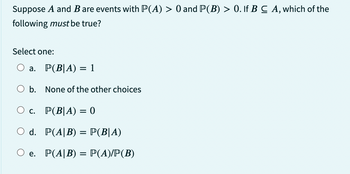Question 52 Quartz and calcite are similar in the following property: Not yet answered Select one: Marked out of a. have similar hardness 2.00 P Flag question b. have similar mineral group O c Both occur in the hexagonal system O d. Both have rhombic cleavage
Question 52 Quartz and calcite are similar in the following property: Not yet answered Select one: Marked out of a. have similar hardness 2.00 P Flag question b. have similar mineral group O c Both occur in the hexagonal system O d. Both have rhombic cleavage
Applications and Investigations in Earth Science (9th Edition)
9th Edition
ISBN:9780134746241
Author:Edward J. Tarbuck, Frederick K. Lutgens, Dennis G. Tasa
Publisher:Edward J. Tarbuck, Frederick K. Lutgens, Dennis G. Tasa
Chapter1: The Study Of Minerals
Section: Chapter Questions
Problem 1LR
Related questions
Question

Transcribed Image Text:Question 52
Quartz and calcite are similar in the following property:
Not yet
answered
Select one:
Marked out of
O a. have similar hardness
2.00
P Flag question
O b. have similar mineral group
O c. Both occur in the hexagonal system
O d. Both have rhombic cleavage
Question 53
lonic bonds are weak bonds that form between polarised molecules
Not yet
answered
Select one:
Marked out of
O True
1.00
P Flag question
O False
Question 54
Total internal reflection of light occurs when the angle of incident is less than the critical angle
Not yet
answered
Select one:
Marked out of
O True.
1.00
P Flag question
O False
Expert Solution
This question has been solved!
Explore an expertly crafted, step-by-step solution for a thorough understanding of key concepts.
Step by step
Solved in 3 steps

Follow-up Questions
Read through expert solutions to related follow-up questions below.
Follow-up Question

Transcribed Image Text:Suppose A and B are events with P(A) > 0 and P(B) > 0. If B C A, which of the
following must be true?
Select one:
a.
b.
P(B|A) = 1
None of the other choices
O c.
P(B|A) = 0
O d. P(A|B) = P(B|A)
e.
P(A|B) = P(A)/P(B)
Solution
Recommended textbooks for you

Applications and Investigations in Earth Science …
Earth Science
ISBN:
9780134746241
Author:
Edward J. Tarbuck, Frederick K. Lutgens, Dennis G. Tasa
Publisher:
PEARSON

Exercises for Weather & Climate (9th Edition)
Earth Science
ISBN:
9780134041360
Author:
Greg Carbone
Publisher:
PEARSON

Environmental Science
Earth Science
ISBN:
9781260153125
Author:
William P Cunningham Prof., Mary Ann Cunningham Professor
Publisher:
McGraw-Hill Education

Applications and Investigations in Earth Science …
Earth Science
ISBN:
9780134746241
Author:
Edward J. Tarbuck, Frederick K. Lutgens, Dennis G. Tasa
Publisher:
PEARSON

Exercises for Weather & Climate (9th Edition)
Earth Science
ISBN:
9780134041360
Author:
Greg Carbone
Publisher:
PEARSON

Environmental Science
Earth Science
ISBN:
9781260153125
Author:
William P Cunningham Prof., Mary Ann Cunningham Professor
Publisher:
McGraw-Hill Education

Earth Science (15th Edition)
Earth Science
ISBN:
9780134543536
Author:
Edward J. Tarbuck, Frederick K. Lutgens, Dennis G. Tasa
Publisher:
PEARSON

Environmental Science (MindTap Course List)
Earth Science
ISBN:
9781337569613
Author:
G. Tyler Miller, Scott Spoolman
Publisher:
Cengage Learning

Physical Geology
Earth Science
ISBN:
9781259916823
Author:
Plummer, Charles C., CARLSON, Diane H., Hammersley, Lisa
Publisher:
Mcgraw-hill Education,